by Jim the Realtor | Nov 12, 2020 | Jim's Take on the Market, Prop 13, Property Tax Re-Assessment, Tax Reform |
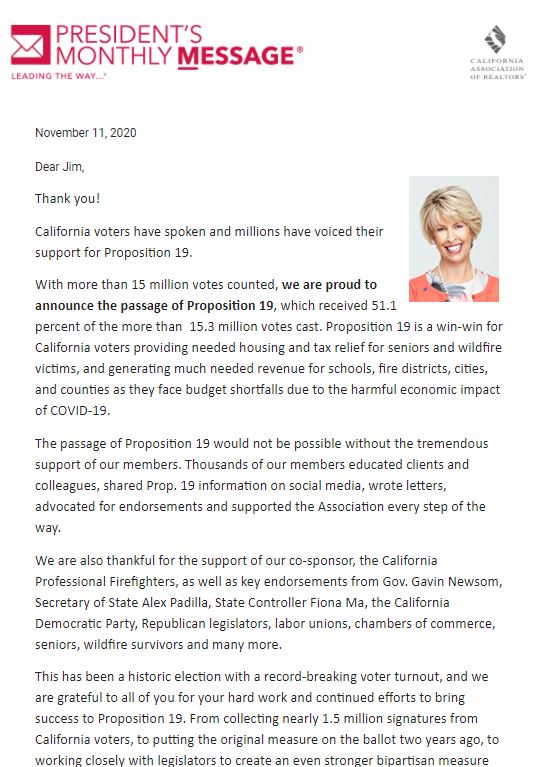
The key components of Prop 19:
Now, older homeowners (55+) can take their old property-tax basis with them when they buy a more expensive home anywhere in the state — up to three times. Homeowners with disabilities will be able to do the same, plus victims of wildfires and other natural disasters and hazardous waste contamination will be able to do so after their home is damaged.
The number of times that a tax assessment can be transferred increased from one to three for persons over 55 years old or with severe disabilities (disaster and contamination victims would continue to be allowed one transfer).
If they pay equal or less in price, the property-tax basis from their previous home transfers.
If they buy up in price, the difference between sales price of old home and purchase price of new home is added to the tax basis (pay full tax on the difference).
New residence must be purchased within two years of the sale of the previous residence.
The measure goes into effect on April 1, 2021.
In California, parents or grandparents could transfer primary residential properties to their children (or grandchildren if all parents are deceased) without the property’s tax assessment resetting to market value. Other types of properties, such as vacation homes and business properties, could also be transferred from parent to child or grandparent to grandchild with the first $1 million exempt from re-assessment when transferred. The ballot measure eliminates the parent-to-child and grandparent-to-grandchild exemption in cases where the child or grandchild does not use the inherited property as their principal residence, such as using a property as a rental house or a second home. When the inherited property is used as the recipient’s principal residence but is sold for $1 million more than the property’s taxable value, an upward adjustment in assessed value would occur. The ballot measure also applied these rules to certain farms. Beginning on February 16, 2023, the $1 million amount would be adjusted each year at a rate equal to the change in the California House Price Index.
https://elections.cdn.sos.ca.gov/ballot-measures/pdf/aca11.pdf
~~~~~~~~~~~~~~~~~~~~~~~~~~~~~~~~~~~~~~~~~~~~~~~~~~~~~~~~~~
Real estate interests raised more than $39 million to support Proposition 19’s passage. Realtors are expected to benefit from increased home sales, both by older homeowners deciding to take advantage of their new tax benefits to move and heirs preferring to sell their parents’ properties rather than pay higher property taxes.
Much of the Realtor-backed campaign for Proposition 19 focused on benefits to wildfire victims and increased funding for wildfire response. But disaster-affected homeowners constitute well under 1% of those eligible for tax relief under Proposition 19, according to an analysis by the California Budget and Policy Center, which found the benefits mostly accruing to older white homeowners.
And while the measure does reserve new tax revenue for wildfire response, the state’s nonpartisan Legislative Analyst’s Office believes that the vast majority of the wildfire funding will not start flowing until 2025 at the earliest.
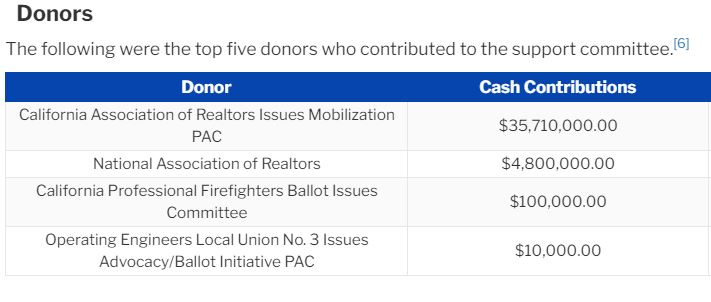
by Jim the Realtor | Sep 10, 2020 | 2021, Boomer Liquidations, Boomers, Jim's Take on the Market, Tax Reform, Thinking of Selling? |
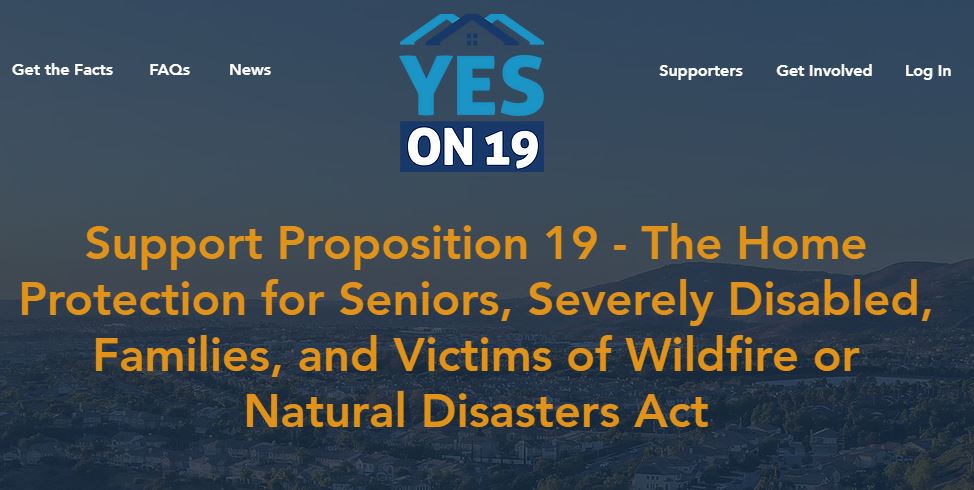
Proposition 19 is on the ballot, and the California Association of Realtors wants you to believe that if it passes, there will be a surge of new inventory from seniors finally being able to sell their homes and take their ultra-low property-tax basis with them to a new home in a county not previously available.
They have deftly orchestrated a campaign that touches on all the hot buttons too. Just look at the title – who doesn’t want to protect the homes of seniors, severely-disabled, families, and victims of wildfire or natural disasters?
But they ignore that seniors have been able to sell and take their ultra-low property-tax basis with them for years – but only if they move to one of the 10 counties in California (out of 58) who have previously approved the benefit.
The ten counties are the major population centers; Alameda, Los Angeles, Orange, Riverside, San Bernardino, San Diego, San Mateo, Santa Clara, Tuolumne, and Ventura. So they want us to believe that seniors have always wanted to move to the sticks – and if passed, the taking of their property-tax basis is the game-changer that gets them to finally move?
Other thoughts:
- How much do seniors need to spend on a replacement home in the sticks? Half a million should do it, so without Prop 19, the regular tax basis would be around $5,000 per year. If a senior pays less than $2,000 annually on their old home….the actual savings isn’t a large amount ($1,000 to $3,000 annually) but yes, every little bit helps.
- Did the grandkids already move to the same town? Probably a more-important ingredient than saving $1,000 to $3,000 per year.
- It only benefits seniors leaving the big cities for small towns. Are they going to live without their modern conveniences like doctors (a big issue), shopping, entertainment, and a way of life to which they’ve become accustomed to for decades, just to save $1,000 to $3,000 per year?
- Prop 19 protects the ability of kids and grandkids to inherit the ultra-low tax basis from the parents and grandparents. How does that create more homes on the market?
But the Association is throwing their full weight behind Prop 19, have gotten the firefighters on board in order to play the wildfire card, and they are advertising on TV:

To me, the thought of Prop 19 creating “tens of thousands of housing opportunities” is preposterous. But seniors are overdue, and maybe it will be the final reason that gets them to move. For that reason, let’s add the passing of Prop 19 to our list of reasons why the 2021 selling season will be like no other!
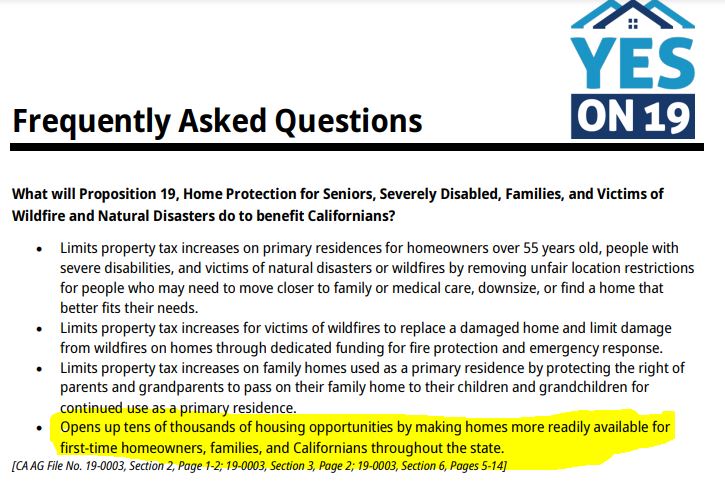
Check out their impressive website:
https://www.carhomecoalition.com/
by Jim the Realtor | Jul 10, 2020 | Jim's Take on the Market, Prop 13, Tax Reform |
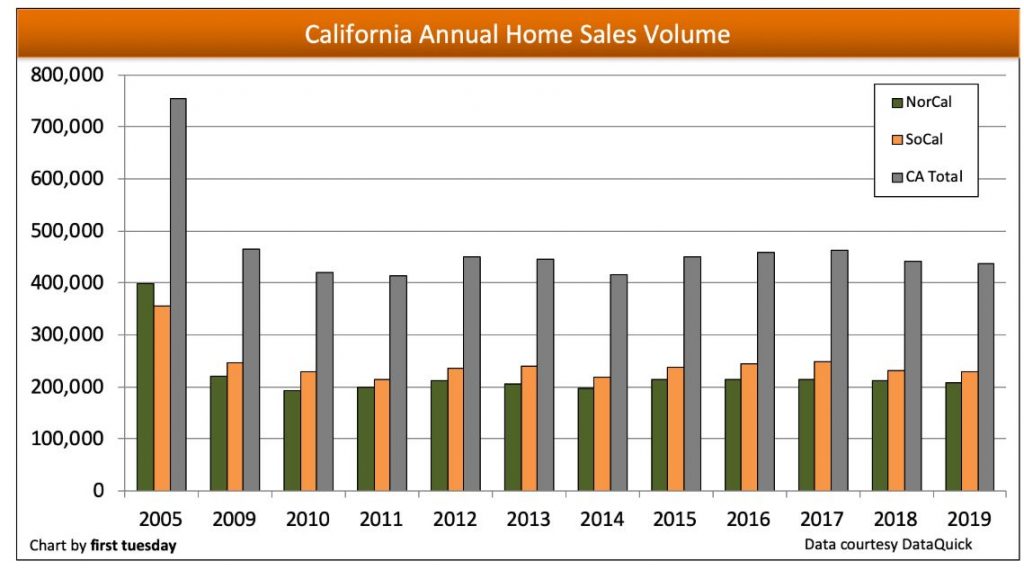
It was called ACA-11 while the legislators considered it, and the realtor-backed initiative is now Prop 19. In our last installment, the legislative analysis included this gem:
Right now, around 80,000 homeowners who are over 55 move to different houses each year without receiving a property tax break. The measure would cause more people to sell their homes and buy different homes because it gives them a tax break to do so. The number of movers could increase by a few tens of thousands.
In the graph above, we see that there were 437,000 homes sales in California last year. The analyst who prepares these studies is saying that 18% of all home sales are seniors buying up, or moving to a county that doesn’t allow for tax-basis transfers? And if this measure passes, even more seniors will move just because of the tax break?
The analysis also includes this tax increase, but doesn’t mention the exclusion for those heirs who occupy the inherited home as their primary residence:
Under current law, between 60,000 and 80,000 inherited properties statewide are excluded from reassessment each year. Under the measure, these properties would instead be reassessed resulting in higher property tax payments. This, in turn, would increase property tax revenues for local governments.
Though the official state analysis seems far-fetched, just the appearance of being an assault on Prop 13 should be its undoing.
Hat tip to SM for sending this in from the Howard Jarvis Taxpayers Association that declares it to be just another political play to generate billions more in property-tax dollars:
https://www.hjta.org/california-commentary/proposition-19-is-latest-assault-on-taxpayers/
The California Association of Realtors has pulled in the firefighters by adding that the excess tax revenues go towards fighting wildfires. Will that be enough smoke & mirrors (pardon the pun) to persuade voters to change Prop 13? The last attempt to pass a similar initiative in 2018 never gained traction, and it’s doubtful that C.A.R. will spend enough advertising dollars to change voters’ minds this time.
by Jim the Realtor | Jul 3, 2020 | Jim's Take on the Market, Prop 13, Tax Reform |
We heard from the C.A.R. president last Friday about realtors joining with the firefighters to push for more tax breaks for seniors. Thanks to Liam who explained the newly-labeled Prop 19 on Twitter yesterday, and for providing the link to the actual calculations being made to justify the changes:


~~~~~~~~~~~~~~~~~~~~~~~~~~~~~~~~~~~~~~~~~~~
Here is the legislative analysis:
https://lao.ca.gov/ballot/2019/190479.pdf
by Jim the Realtor | Jun 27, 2020 | Jim's Take on the Market, Tax Reform |

June 26, 2020
Dear Jim,
Today, the California State Legislature passed a strong bipartisan measure (Assembly Constitutional Amendment 11) co-sponsored by the CALIFORNIA ASSOCIATION OF REALTORS® (C.A.R.) and the California Professional Firefighters that is poised to be placed on the November ballot. This new ballot initiative is known as “The Home Protection for Seniors, Severely Disabled, Families, and Victims of Wildfire or Natural Disasters Act” (ACA 11).
This is great news as it builds on C.A.R.’s original initiative, strengthening the provisions we care most about and incorporates dedicated funding for fire protection and emergency response to safeguard millions of lives in communities across the state. The new initiative will continue to expand Proposition 13 property tax portability for all homeowners over 55 years old, people with severe disabilities, and wildfire victims by removing unfair location and cost restrictions to allow homeowners to move anywhere in the state. In addition, it will open up housing inventory throughout California, creating home ownership opportunities for first-time homebuyers.
This legislative solution passed through the California State Legislature with two-thirds support in the State Assembly and State Senate with strong bipartisan support. Together, C.A.R. and the California Professional Firefighters built an unprecedented broad and diverse coalition including local elected officials, business groups, labor, agriculture, Republicans and Democrats. Some of the supporters include the California Farm Bureau, California Fresh Fruit Association, California Forestry Association, California Business Roundtable, California Building Industry Association, California Business Properties Association, California Cattlemen’s Association, as well as wildfire victims, local elected officials, school officials, and senior groups.
This updated initiative generates hundreds of millions of dollars in annual revenue for local governments and school districts without raising property tax rates. It also creates a historic dedicated Fire Response Fund providing needed revenue to help protect millions of homes and lives across the state, including dedicated revenue for historically underfunded fire districts in rural and urban communities.
In addition, the initiative will provide added tax relief for California’s family-owned farms and ranches. The additional tax savings for a farmer or rancher will help protect generational farming.
Lastly, the initiative continues to constitutionally protect the right for parents and grandparents to pass the family home to their children and grandchildren so they can afford to live in the home as intended by Propositions 58 and 193. Since family transfer benefits have been under attack and face potential elimination, this initiative protects family homes for Californians.
The next step is for Governor Newsom to sign legislation in the next few days that will officially place ACA 11 on the ballot.
We are in an even stronger position to pass this important initiative that will improve housing affordability, benefit communities, and all Californians. I appreciate your support. Our team will be providing you with updates soon on how to get involved.
Sincerely,
Jeanne Radsick, C.A.R. President
~~~~~~~~~~~~~~~~~~~~~~~~~~~~~~~~~~~~~~~~~~~~~~~~~~~~~~~~~~~
I need to keep the tax initiatives straight – this one allows seniors to buy a home in any California county and take their previous property-tax basis with them (called ‘property tax portability’). If seniors buy down in price, then the previous taxation applies. If a senior buys UP in price, there is a formula here at 2B:
(2) For purposes of this subdivision:
(A) For any transfer of taxable value to a replacement primary residence of equal or lesser value than the original primary residence, the taxable value of the replacement primary residence shall be deemed to be the taxable value of the original primary residence.
(B) For any transfer of taxable value to a replacement primary residence of greater value than the original primary residence, the taxable value of the replacement primary residence shall be calculated by adding the difference between the full cash value of the original primary residence and the full cash value of the replacement primary residence to the taxable value of the original primary residence.
(3) An owner of a primary residence who is over 55 years of age or severely disabled shall not be allowed to transfer the taxable value of a primary residence more than three times pursuant to this subdivision.
https://leginfo.legislature.ca.gov/faces/billTextClient.xhtml?bill_id=201920200ACA11
I still think they are wildly optimistic that it will generate ‘hundreds of millions of dollars in annual revenue’.
by Jim the Realtor | Jun 7, 2020 | Homeless Cure, Jim's Take on the Market, Local Government, Prop 13, Tax Reform |

This potential bond issue (and resulting property-tax payments) is for the City of San Diego only. From the U-T:
Supporters of a $900 million housing bond say they will continue pursuing the measure for the November ballot, despite the sharp economic downturn reducing incomes for many San Diego property owners who would be paying the tax increase.
The decision was based primarily on a new telephone poll of 850 likely voters that showed 69 percent support the measure, just above the 66.7 percent needed for approval and a drop in support of only 2 percent since last November.
“Until we saw the poll results, it was totally up in the air,” said Stephen Russell, who is spearheading the effort for the San Diego Housing Federation. “When we went to poll, we thought we were going to see cratering in the numbers. It was compelling that we are only two points lower than our polling in November.”
Some critics say that an economic downturn is the wrong time to burden property owners with higher property taxes. Russell said the people most affected by the downturn are low-wage workers who pay rent and are most vulnerable to becoming homeless.
The proposal would raise taxes on San Diego property owners to pay for roughly 7,500 subsidized apartments, 2,800 units for the formerly homeless and 4,700 units for veterans, senior citizens, the disabled and low-income families. In addition to the local money it would raise, the measure would help San Diego secure a greater share of state and federal money devoted to homelessness and affordable housing, by providing local matching funds.
The bond measure would cost property owners $19 per year for every $100,000 of assessed value. The average homeowner with a $600,000 property would pay $115 per year, he said.
But owners of large amounts of commercial, industrial or residential property would pay significantly more.
(more…)
by Jim the Realtor | May 6, 2020 | Jim's Take on the Market, Tax Reform |
The California Association of Realtors president sent this letter out today with different verbiage about the reassessment of commercial properties – the way it sounds in her letter (in italics below) makes it sound different than what’s been widely published. I can’t find any changes to the original measure, excerpted here:
The measure requires commercial and industrial properties, as well as vacant land not intended for housing, commercial agriculture, or protected open space to be taxed based on their market value, as opposed to their purchase price. A property’s market value is what it could be sold for today. The measure’s shift to market value assessment is phased in over a number of years beginning in 2022-23. For properties in which the majority of space is occupied by small businesses—defined as businesses that own California property and have 50 or fewer employees—the shift to market value taxation would not begin until 2025-26 or a later date set by the Legislature.
Properties owned by individuals or businesses whose property holdings in the state total less than $3 million (adjusted for inflation biannually beginning in 2025) are exempt from market value taxation. These properties would continue to be taxed based on purchase price. Similarly, residential properties would continue to be taxed based on purchase price.

May 6, 2020
Dear Jim,
During this COVID-19 pandemic, we are facing some of the biggest challenges in a generation, experiencing severe stress and uncertainty with our businesses, our families and our way of life. Our daily lives have changed overnight, and as we prepare to transition to a new normal, we, at C.A.R., are focused on addressing our members’ most immediate needs and advancing policies that will strengthen economic recovery and the housing market, supporting REALTORS®, our clients and our communities.
I am writing today to share the news that after collecting and submitting nearly 1.5 million signatures, C.A.R.’s ballot initiative has recently qualified for the November 2020 ballot — and at our C.A.R. Board of Directors meetings last week, the Board overwhelmingly voted to lead the campaign effort to win passage of The Family Home Protection and Fairness in Property Tax initiative in the upcoming election.
The Family Home Protection and Fairness in Property Tax initiative is needed now more than ever and is key to a California Housing Market Economic Recovery. Prior to the COVID-19 pandemic that changed the way we work and live, C.A.R.’s actions placed us in the position we are in today to support this initiative: providing housing relief for millions of seniors, improving homeownership opportunities throughout the state, and generating needed revenues for local school districts, cities and counties to help fill budget deficits and critical funding for schools, public safety, healthcare and homeless services, local housing projects and more.
In April 2019, C.A.R.’s Board of Directors supported the first official step in the initiative process by submitting it to the Attorney General. Then in October 2019, the Board of Directors supported funding the qualification and signature collection to place this initiative on the ballot. The campaign’s efforts resulted in submitting a record number of signatures in time for the November ballot — qualifying the measure under budget, with over $1 million in cost-savings.
This initiative is a win-win for everyone — creating relief for seniors and victims of wildfires, homeownership opportunities throughout the state and needed revenue for local government and school districts at a time when they need it most.
Key Provisions:
Benefits Homeowners, Seniors, People with Disabilities and Natural Disaster Victims
This initiative removes unfair location and price restrictions, so that homeowners 55 years or older, people with severe disabilities, and victims of wildfires or natural disasters can transfer their existing property tax base to a replacement home anywhere in California. Without this change, many have felt trapped in their homes and could not afford to move closer to their families or health care facilities. This eliminates hurdles for homeowners, including those in our most vulnerable population at this most critical time.
Constitutionally Protects Family Homes
The initiative protects the right of parents and grandparents to pass the family home on to their children, so they can afford to live in the home. This family home tax savings, termed a “special rule” in the State Legislature, has been targeted by the media and by state legislators for removal. This initiative safeguards family homes as intended under Proposition 58 and Proposition 193.
Benefits Local Communities and Schools
This initiative provides long-term benefits for local municipalities and schools, generating hundreds of millions of dollars to help fund public safety, hospitals, health care services, homeless programs and local housing projects. The initiative does not raise or change tax rates, it simply defines events that may trigger future limited assessments. For example, the initiative requires disclosure and reporting of corporate ownership changes and reassessment of business property resulting from certain ownership changes — which will generate over $269 million per year, according to the California Board of Equalization. This modest reform is even backed by business groups.
We are supporting this initiative because we believe it is a policy that the housing market desperately needs for economic recovery, addressing the housing needs of millions of Californians, while providing revenue for schools and local communities. This is why recent polling conducted this past month confirms consistent voter support across the state for the initiative’s provisions.
As California transitions to a new normal, this initiative has come at an important moment. It will help ease housing affordability and accessibility for Californians, stimulate the housing market and provide funding for our local municipalities and schools.
I am proud to announce C.A.R.’s full support of The Family Home Protection and Fairness in Property Tax initiative and hope you will join me in helping to win its passage in November.
Sincerely,
Jeanne Radsick
C.A.R. President
by Jim the Realtor | Mar 19, 2020 | Jim's Take on the Market, Local Government, Tax Reform |

Federal: Congress is working through several fiscal policy proposals. It is very likely that whatever relief is passed will include tax incentives that will need to be carefully planned for.
The Treasury and IRS announced on March 17 that the tax deadline will be extended 90 days, to July 15, and the IRS will waive interest and penalties for certain taxpayers. The delay is available to people who owe $1 million or less and corporations that owe $10 million or less.
California: The state has granted extensions to individual filers, partnerships and LLCs and quarterly estimated tax payments: Filing and payment is due June 15. The Employment Development Department and California Department of Tax and Fee Administration have also released guidelines.
by Jim the Realtor | Feb 13, 2020 | Boomer Liquidations, Boomers, Jim's Take on the Market, Tax Reform

Excerpts from the latimes article:
Ever since the SALT cap went into effect in 2018, the hunt has been on for signs that it has prompted more wealthy residents to move from high-tax to low-tax states.
“Despite some recent claims that it has,” Lucy Dadayan of the Tax Policy Center wrote on Feb. 10, “the data available support the view that ‘We don’t have any idea.’”
News articles crop up from time to time about things like surging purchaser interest in Florida condos from residents from New York or California. But they’re anecdotal, not data-driven. It’s hard to say whether the interest doesn’t reflect the pretax bill trend or bargains left over from a lengthy Florida real estate slump.
“Migration has been a problem for a number of years,” Dadayan told me. “SALT cap or not, New York has to be concerned about losing people.” Internal Revenue Service statistics show that New York lost more than 76,000 taxpayers from 2017 to 2018, nearly 1% of its taxpayers and the largest outflow among high-population states.
But as Dadayan observes, attributing that migration to concerns about high taxes in general or the SALT cap specifically is another matter. The top destination for fleeing New Yorkers in recent years has been California, which has a higher top income tax rate. “Migration is not necessarily determined by taxes,” she says.
The SALT cap raised hackles in high-tax states. New York Gov. Andrew Cuomo pronounced it “an economic civil war that helps red states at the expense of blue states.”
Pinpointing the relationship between the SALT cap and interstate migration is difficult for several reasons. One is that it’s too early to tell. The Internal Revenue Service has released taxpayer data only through the 2017 tax year; statistics for 2018 tax payments won’t be available until December.
(more…)
by Jim the Realtor | Nov 13, 2019 | Tax Reform, Thinking of Selling?, Tips, Advice & Links
Widowed taxpayers.
If you are a widowed taxpayer who doesn’t meet the 2-year ownership and residence requirements on your own, consider the following rule. If you sell your home within 2 years of the death of your spouse and you haven’t remarried at the time of the sale, then you may include any time when your late spouse owned and lived in the home, even if without you, to meet the ownership and residence requirements.
Also, you may be able to increase your exclusion amount from $250,000 to $500,000. You may take the higher exclusion if you meet all of the following conditions.
- You sell your home within 2 years of the death of your spouse;
- You haven’t remarried at the time of the sale;
- Neither you nor your late spouse took the exclusion on another home sold less than 2 years before the date of the current home sale; and
- You meet the 2-year ownership and residence requirements (including your late spouse’s times of ownership and residence if need be).
https://www.irs.gov/publications/p523















